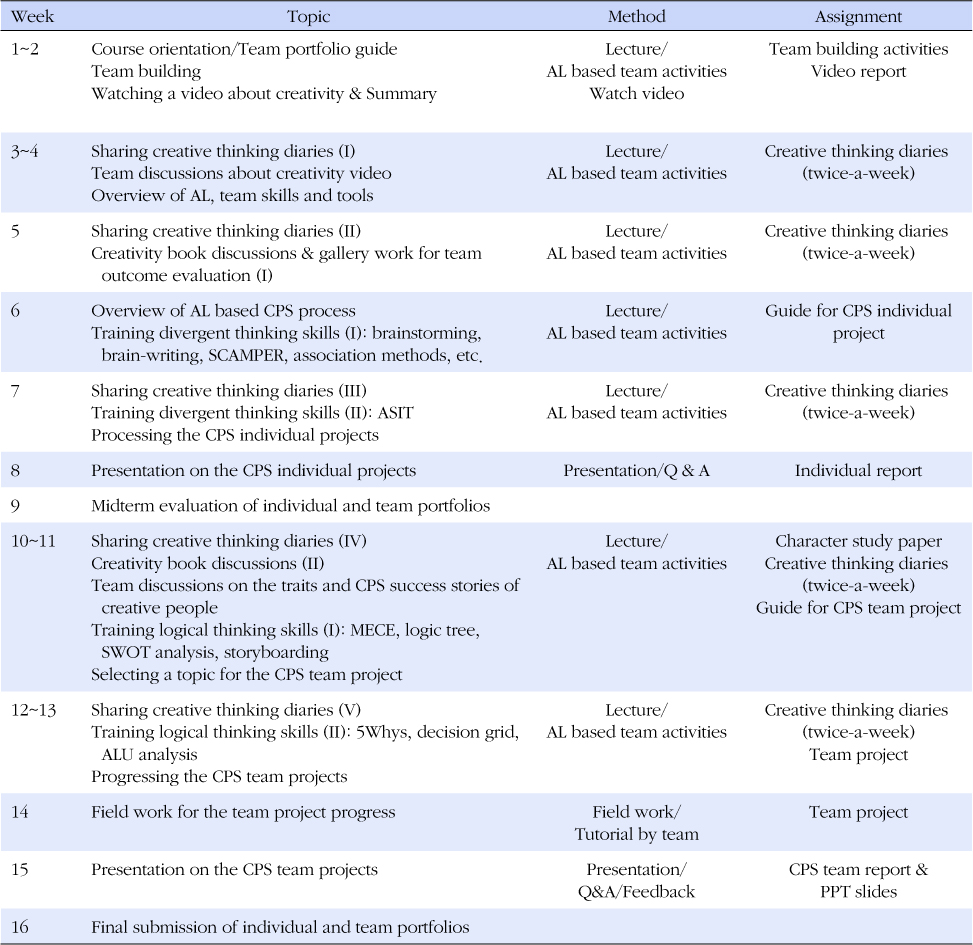1College of Nursing · Research Institute of Nursing Science, Chonnam National University, Korea.
2Research Institute of Nursing Science, Chonnam National University, Korea.
3Department of Nursing, Honam University, Korea.
Copyright © 2014 Korean Academy of Nursing Administration
This is an open access article distributed under the terms of the Creative Commons Attribution Non-Commercial License (http://creativecommons.org/licenses/by-nc/3.0/), which permits unrestricted non-commercial use, distribution, and reproduction in any medium, provided the original work is properly cited.

AL=Action Learning; CPS=Creative problem-solving; SCAMPER=Substitute, combine, adapt, modify, magnify, minimize, put to other use, eliminate, reverse, rearrange; ASIT=Advanced systemic inventive thinking; MECE=Mutually exclusive collectively exhaustive; SWOT=Strength, weakness, opportunity, threat; ALU=Advantage, limitation, unique qualities.

Creative Problem-Solving Course Outline
AL=Action Learning; CPS=Creative problem-solving; SCAMPER=Substitute, combine, adapt, modify, magnify, minimize, put to other use, eliminate, reverse, rearrange; ASIT=Advanced systemic inventive thinking; MECE=Mutually exclusive collectively exhaustive; SWOT=Strength, weakness, opportunity, threat; ALU=Advantage, limitation, unique qualities.
Homogeneity Test for General Characteristics between Experimental and Control Groups (N=65)
Exp=Experimental group; Cont=Control group; †Fisher exact test.
Homogeneity Test for Dependent Variables between Experimental and Control Groups (N=65)
Exp=Experimental group; Cont=Control group.
Group Comparisons on Dependent Variables at Posttest (N=65)
Exp=experimental group; Cont=control group; †F score of from Analysis of Covariance with pretest scores as covariates.
AL=Action Learning; CPS=Creative problem-solving; SCAMPER=Substitute, combine, adapt, modify, magnify, minimize, put to other use, eliminate, reverse, rearrange; ASIT=Advanced systemic inventive thinking; MECE=Mutually exclusive collectively exhaustive; SWOT=Strength, weakness, opportunity, threat; ALU=Advantage, limitation, unique qualities.
Exp=Experimental group; Cont=Control group; †Fisher exact test.
Exp=Experimental group; Cont=Control group.
Exp=experimental group; Cont=control group; †F score of from Analysis of Covariance with pretest scores as covariates.